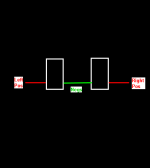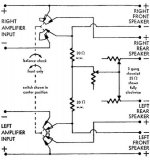Just been reading about the famous Hafler circuit to get 4-channel surround sound from a 2-channel amp. This is the description:
Then I ran a single wire from the right-positive post on the power-amp to the positive post on the right rear speaker. Then (2) a single wire from its negative post to the negative post on the left rear speaker. Then (3) I completed the circuit with a single wire from the left rear's positive post back to the left-positive post on the power-amp. (Oh yes, an on-off switch stuck anywhere in the circuit; alternatively a volume control.)
In shorthand: R+ to R+, R- to L-, L+ to L+.
That's the famous Hafler Circuit, given to the world by the famous designer David Hafler (and picked up and made into millions of dollars by Mr Dolby). The effect is subtle; it "warms up" the acoustic feel of the room. It isn't time-delay reverb, just an out-of-phase 'difference' between left and right, which itself is neither left nor right.
What I want to know is if it is safe for the amp as there is a mention of low impedance dangers
Any thoughts?
Then I ran a single wire from the right-positive post on the power-amp to the positive post on the right rear speaker. Then (2) a single wire from its negative post to the negative post on the left rear speaker. Then (3) I completed the circuit with a single wire from the left rear's positive post back to the left-positive post on the power-amp. (Oh yes, an on-off switch stuck anywhere in the circuit; alternatively a volume control.)
In shorthand: R+ to R+, R- to L-, L+ to L+.
That's the famous Hafler Circuit, given to the world by the famous designer David Hafler (and picked up and made into millions of dollars by Mr Dolby). The effect is subtle; it "warms up" the acoustic feel of the room. It isn't time-delay reverb, just an out-of-phase 'difference' between left and right, which itself is neither left nor right.
What I want to know is if it is safe for the amp as there is a mention of low impedance dangers
Any thoughts?
Not the answer you're looking for, but perhaps the answer you need: I would rather search on eBay for a really cheap old lexicon processor, if you can find one. MC-4, MC-12, MC-8, etc. Proper surround upmixing is difficult to get right. It's of paramount importance to send only parts of the signal (the ambience) to the surrounds, not the whole signal. And the surrounds should be delayed also. It's probably hard to beat Harman's Logic 7, which was developed by dr David Griesinger. For Logic 7, you need Lexicon. No large difference between the Logic 7 algorithm in the old and new processors, so an old unit will serve you well.
A variation of Hafler's idea is to connect the + post on each channel to either side of a single driver. Works really well in car audio for filling in that centre hole. It only plays the difference signal i.e. the mono component is omitted.
I tried all this stuff in the 70s.
I tried all this stuff in the 70s.
Meh for a single driver. Use 2 small speakers; + on both connected to + of each LR spkr. The '-' on these small 'surround' speakers should be tied together - or better, connected via a couple 100uF bipolar elco to act as a high-pass (value determined on test in-situ).
This is cheap and more-than-cheerful.
This is cheap and more-than-cheerful.
"Low impedance dangers" I think, relates to amplifier power capabilty. Prior to the 1980s, there were still a lot of very "cheap and cheerful" stereo systems and these were often in the 5-20W (low) power range with minimum 8 ohm load ratings because the "cheap" part just didn't afford the necessary current to drive low impedance loads. Had more been spent on solid power amplifiers as are common now, you could have safely driven not only 4 ohm loads but perhaps 2 ohm loads too.
I'd say that such warnings were to cover the manufacturer's exposure to consumer claims, given that overload protection systems were quite rudimentary (wire fuse only) and usually ineffective, back in the day. In other words, it was going to be your fault if you blew the amplifier with a total load that dipped below the minimum speaker load rating - whether it was Hafler's surround system or any extra speakers effectively in parallel the main speakers.
It's actually a worse situation when you connect a second set of speakers to your 8 ohm amplifier and switch the speaker selector to "both", just because you can. Where the amplifier is big enough to drive low impedance loads, people have been doing this for decades without problem though, provided they didn't see this as a means to get party sound levels from a small system.
As TBTL suggests, safety is still down to how hard you push your audio system, regarding whether it is suitable for any load, within a recommended 8 ohms lower limit or not. If there is no inbuilt overload protection such as current or power limiting, there is always a likelihood of amplifier failure, possibly followed by speaker failure too.
I'd say that such warnings were to cover the manufacturer's exposure to consumer claims, given that overload protection systems were quite rudimentary (wire fuse only) and usually ineffective, back in the day. In other words, it was going to be your fault if you blew the amplifier with a total load that dipped below the minimum speaker load rating - whether it was Hafler's surround system or any extra speakers effectively in parallel the main speakers.
It's actually a worse situation when you connect a second set of speakers to your 8 ohm amplifier and switch the speaker selector to "both", just because you can. Where the amplifier is big enough to drive low impedance loads, people have been doing this for decades without problem though, provided they didn't see this as a means to get party sound levels from a small system.
As TBTL suggests, safety is still down to how hard you push your audio system, regarding whether it is suitable for any load, within a recommended 8 ohms lower limit or not. If there is no inbuilt overload protection such as current or power limiting, there is always a likelihood of amplifier failure, possibly followed by speaker failure too.
With 2 (small ?) "surround" speakers, connected with a HPF cap (see my prev. post) it is quite unlikely you will overload the amp. Most of the heavy load is in the bass, not the upper freq. ranges. So unless you playback a 180 deg out-of phase - or heavily decorellated - white noise (just for for example), it is unlikely that the amp will ever ever go into overload with the 2 additional piggy-backed "surround" speakers.
I mean seriously, do your audio recordings really contain such amount of "ambiance" or any other sorts of channel imbalance that would effectively overload the amp? Because it is only the magnitude of L-R (or R-L) that is the added load here. In a nicely set up amp, the L+R doesn't even register on the "surround" speakers. (With the practical exception if one channel is dead or dead quiet etc).
My 2c: just add the HPF cap.
I mean seriously, do your audio recordings really contain such amount of "ambiance" or any other sorts of channel imbalance that would effectively overload the amp? Because it is only the magnitude of L-R (or R-L) that is the added load here. In a nicely set up amp, the L+R doesn't even register on the "surround" speakers. (With the practical exception if one channel is dead or dead quiet etc).
My 2c: just add the HPF cap.
In the 1970's, I built a few surround systems using 4-5 identical, full range loudspeakers. This was the way to get the best from Quadraphonic and Hafler systems then. The low pass filter caps were actually much larger than those shown in the basic system that was promoted in the audio press and yes, it did overload and blow the amp, more than once.
I think that present day stereo mixes are quite different to what was recorded in the 60s-70's. It was common to hear recordings with backing musicians fully in one channel or the other and just the lead vocalist or musician mixed 50:50. Often the drums and instruments were spead about inconsistently too. Many early Beatles recordings were examples of such crude stereo mix techniques.
You have to imagine that stereo was still a novelty in some countries and accentuated stereo effects were a feature rather than the joke they are now. "Remastering" often seems to be necessary to correct these outdated mixes as much as clean up the noise and defects from years of handling and storage.
Thus, you got quite "interesting" results using Hafler's surround-sound network with those original, crudely mixed types of programme. However, if you are talking of current recordings or more subtle microphone techniques used for ensembles, where the L and R channels are not markedly different, it really is'nt worth wasting time on it, IMHO.
using Hafler's surround-sound network with those original, crudely mixed types of programme. However, if you are talking of current recordings or more subtle microphone techniques used for ensembles, where the L and R channels are not markedly different, it really is'nt worth wasting time on it, IMHO.
I think that present day stereo mixes are quite different to what was recorded in the 60s-70's. It was common to hear recordings with backing musicians fully in one channel or the other and just the lead vocalist or musician mixed 50:50. Often the drums and instruments were spead about inconsistently too. Many early Beatles recordings were examples of such crude stereo mix techniques.
You have to imagine that stereo was still a novelty in some countries and accentuated stereo effects were a feature rather than the joke they are now. "Remastering" often seems to be necessary to correct these outdated mixes as much as clean up the noise and defects from years of handling and storage.
Thus, you got quite "interesting" results
 using Hafler's surround-sound network with those original, crudely mixed types of programme. However, if you are talking of current recordings or more subtle microphone techniques used for ensembles, where the L and R channels are not markedly different, it really is'nt worth wasting time on it, IMHO.
using Hafler's surround-sound network with those original, crudely mixed types of programme. However, if you are talking of current recordings or more subtle microphone techniques used for ensembles, where the L and R channels are not markedly different, it really is'nt worth wasting time on it, IMHO.- Status
- This old topic is closed. If you want to reopen this topic, contact a moderator using the "Report Post" button.
- Home
- Amplifiers
- Solid State
- Cheap and cheerful surround sound?

